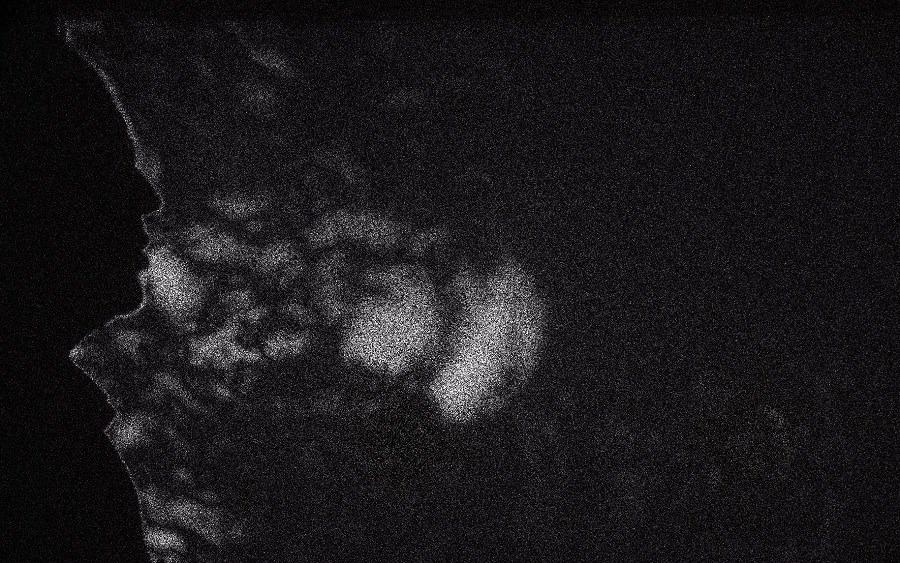Dec 22 2020
A researcher has developed a novel technique for imaging the exhaled breath of individuals while they are singing, or speaking to someone, potentially offering a better understanding of the effectiveness of face masks and the transmission of various diseases, like COVID-19.
 The new imaging technique has been used to capture the exhaled breath of a person speaking. This is a demonstration of the published imaging technique that is being further investigated. The imaging shows only the temperature change associated with exhaled breath, which does not necessarily reflect the movement of viral particles contained in the breath. Image Credit: Thomas Moore, Rollins College.
The new imaging technique has been used to capture the exhaled breath of a person speaking. This is a demonstration of the published imaging technique that is being further investigated. The imaging shows only the temperature change associated with exhaled breath, which does not necessarily reflect the movement of viral particles contained in the breath. Image Credit: Thomas Moore, Rollins College.
Scientists believe the SARS-CoV-2 virus is primarily spread through respiratory droplets that can be carried in the breath or expelled through coughing or sneezing. But it is also transmitted by airborne aerosols, which are small particles that remain in the air longer than the larger droplets.
Thomas Moore, Rollins College
He continued, “The system I developed provides a way to estimate how far the breath travels before being dispersed into the surrounding air and can provide visual evidence that masks significantly limit the distance the breath travels in the air.”
To image the temperature variations between the surrounding air and the exhaled breath, Moore employed a variation of electronic speckle pattern interferometry. The study has been published in the Optical Society (OSA) journal, Applied Optics.
Besides this, the novel method can be used to analyze the details of the flow of breath from the mouth while individuals are singing or speaking. Such an approach may prove handy for speech therapy and music instruction.
From Musical Instruments to People
Moore initially designed the imaging technology to investigate the airflow via musical instruments, like organ pipes.
In response to the COVID-19 pandemic, I began imaging the breath of people speaking and singing. I realized that by scaling up my existing system, I could likely determine how far the breath extends and how effective masks may be in limiting the extent of the breath.
Thomas Moore, Rollins College
A majority of the existing techniques used to image the exhaled breath involve costly equipment and they can image just a comparatively small region. Hence, to address such limitations, Moore developed a new system that makes use of standard optical components available in the market.
I used a variation of electronic speckle pattern interferometry, which has been used for many years to study the vibrational patterns of solid objects. The innovation was to change the system in such a way that it can be used to image transparent things, such as the breath, instead of solid vibrating objects.
Thomas Moore, Rollins College
The new imaging system leverages the fact that the speed of light will vary based on the temperature of the air it flows through. Since the breath is warmer compared to the surrounding atmosphere, the light which is transmitted via the breath reaches the camera somewhat sooner than the light that did not travel through it. Scientists can use this slight variation in the speed of light to generate images of exhaled breath.
To test the novel system, Moore imaged the breath of a professional musician playing flute—one of the few musical instruments in which the musician directly blows into the surrounding air—and a couple of professional vocalists singing.
“The work with the musicians immediately confirmed that the system worked well and could be used to study a variety of problems,” Moore added.
Changing the Air Flow
At present, Moore is using the new technique to analyze the effectiveness of masks at decreasing the distance traveled by the exhaled aerosols. In particular, Moore is focused on studying singing because according to studies, more amount of aerosol is exhaled while speaking or singing loudly than when speaking in normal tones.
Besides this, Moore is working to render the new system more stable against vibrations and to additionally boost the size of the system to image bigger regions.
According to Moore, the new method has already demonstrated new data that may influence how people approach the masking and distancing requirements, particularly when they are outdoors. Moore hopes to shortly submit these outcomes for publication.
“The pandemic has caused an economic catastrophe for many musicians, and any information we can give them that will help them get back to work is important. We have had a lot of interest from the musical community, and I expect the healthcare community will also be interested once we begin to publish our results,” Moore concluded.
Journal Reference:
Moore, T R (2020) Visualization of exhaled breath by transmission electronic speckle pattern interferometry. Applied Optics. doi.org/10.1364/AO.410784.